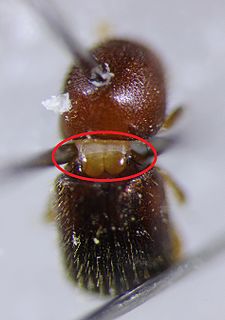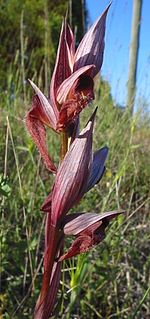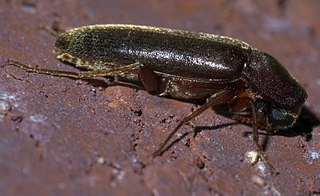
The telephone-pole beetle is a beetle native to the eastern United States, and the only living representative of the otherwise extinct family Micromalthidae. Classification of M. debilis was historically controversial and unsettled. The species, first reported by John Lawrence LeConte in 1878, was long considered one of the Polyphaga, and placed in the Lymexylidae or Telegeusidae, or as a family within the Cantharoidea. However, characteristics of larvae, wings, and male genitalia show that it is in the suborder Archostemata, where it has been placed since 1999.

The term mycangium is used in biology for special structures on the body of an animal that are adapted for the transport of symbiotic fungi. This is seen in many xylophagous insects, which apparently derive much of their nutrition from the digestion of various fungi that are growing amidst the wood fibers. In some cases, as in ambrosia beetles, the fungi are the sole food, and the excavations in the wood are simply to make a suitable microenvironment for the fungus to grow. In other cases, wood tissue is the main food, and fungi weaken the defense response from the host plant.

Serapias vomeracea, common name long-lipped serapias or the plow-share serapias, is a species of orchid in the genus Serapias.
Cyrioides elateroides is a species of beetle in the family Buprestidae native to southwest Western Australia. It was described by the English entomologist Edward Saunders in 1872, the type specimen collected along the Swan River. Saunders noted it to be similar in coloration to the related C. vittigera but had its markings were patterned differently.
Atractocerus is a genus of beetles in the family Lymexylidae. The most recent revision of the family treats several small or monotypic genera as synonyms of Atractocerus, though some authors continue to use the older generic names (e.g.).
Lymexylon is a genus of beetles in the family Lymexylidae, containing the following species:
Urtea graeca is a species of beetles in the family Lymexylidae, the only species in the genus Urtea.
Australymexylon is a genus of beetles in the family Lymexylidae, containing the following species:
Melittommopsis is a genus of beetles in the family Lymexylidae, containing the following species:
Protomelittomma insulare is a species of beetle in the family Lymexylidae, the only species in the genus Protomelittomma.

Quentin Duane Wheeler is an American entomologist, taxonomist, author and newspaper columnist, and is the founding director of the International Institute for Species Exploration. He was the fourth President of the State University of New York College of Environmental Science and Forestry, in Syracuse, New York. Other positions have included: professor of entomology at Cornell University and Arizona State University; Keeper and Head of Entomology at the Natural History Museum in London; and Director of the Division of Environmental Biology at the National Science Foundation.
Homoeodera elateroides, the click beetle-like fungus weevil is a species of beetle belonging to the family Anthribidae. The species is endemic to Saint Helena.
Homoeodera is a genus of beetles belonging to the Anthribidae family.
Tmesisternus elateroides is a species of beetle in the family Cerambycidae. It was described by Gestro in 1876. It is known from Papua New Guinea.

Melittomma sericeum, the chestnut timberworm, is a species of ship-timber beetle in the family Lymexylidae. It is found in North America.
Haematochiton is a genus of pleasing fungus beetles in the family Erotylidae. There are at least two described species in Haematochiton.
Cerophytum is a genus of rare click beetles in the family Cerophytidae. There are at least four described species in Cerophytum.

Trixagus is a genus of small false click beetles in the family Throscidae. There are at least 20 described species in Trixagus.
Telegeusis nubifer is a species of long-lipped beetle in the family Telegeusidae. It is found in North America.







